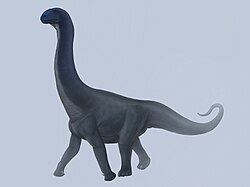Paleobiota
| Genus | Species | Dist. | Member | Material | Notes | Images |
|---|---|---|---|---|---|---|
C. oxoniensis [2] | Great Casterton Quarry | Freshwater Series | "Rutland Dinosaur" specimen consisting of " cervicals `2±14', some with ribs of the left or both sides; neural arches, spinesor centra of at least 11 dorsals and many thoracic rib fragments; at least four sacral centra, with parts of theparapophyses; four sacral ribs and possible sacral spines; 13 anterior caudals; several damaged chevrons;fragments of both ilia and the left ischium; and the right femur." [1] |  | ||
| Sauropoda | Indet | Woodeaton Quarry | Undescribed. [3] | |||
| Dinosauria | ||||||